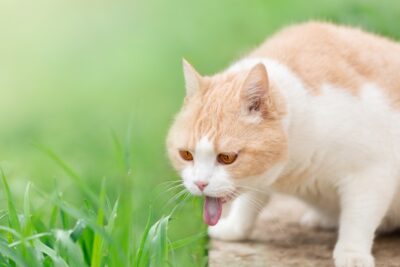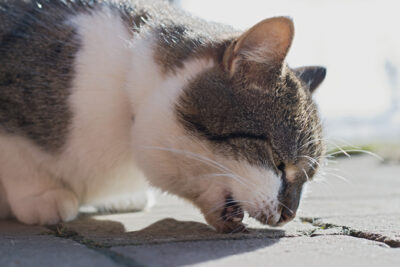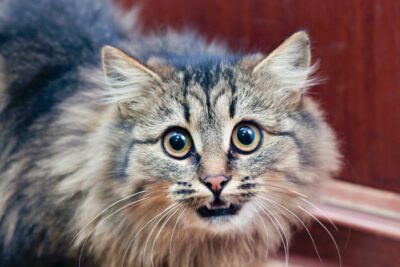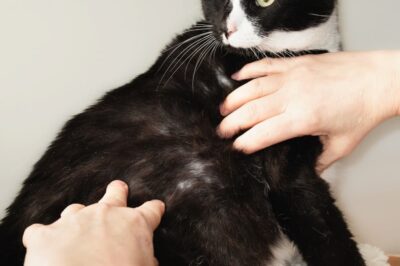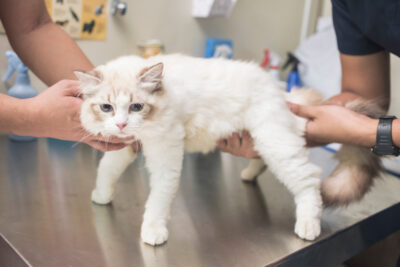Cat Dry Skin: Causes and How to Help

All featured products are chosen at the discretion of the GreatPetCare editorial team and do not reflect a direct endorsement by the author or reviewer.
Dry skin is something most of us deal with from time to time, whether it’s caused by cold weather, dehydration, or diet. Our feline companions can experience it too, though it’s often harder to spot beneath all that fur. Signs might show up as excessive scratching or skin flakes (dandruff) left behind on their favorite napping spots.
“Most cases of dry skin and dandruff in cats are relatively benign and should not be cause for panic,” says Max Jones, DVM, partner and veterinarian at Bahama Road Veterinary Hospital. That said, dry skin can sometimes be a red flag for an underlying health issue.
Let’s explore what causes dry skin in cats, how to recognize the signs, and the best ways to help your kitty feel more comfortable.
Signs of Dry Skin in Cats
The most telltale sign of dry skin is white or grayish flakes of skin in the fur, known as feline dandruff, Dr. Jones says. You might notice these dandruff flakes on your bedding, favorite lounging spots, or fur, although it can be harder to see on cats with light-colored fur.
“Dandruff may be harmless, especially if mild or only noted occasionally, but persistent or severe cases can signal underlying health, dietary, or environmental issues and should be investigated,” Dr. Jones adds.
Other signs of dry skin in cats pet parents can watch for include:
- Frequent itching or scratching
- Dull or rough coat
- Red, irritated, or raw skin patches
If you notice any of these signs, schedule an appointment with your veterinarian, especially if symptoms are severe or worsen.
What Causes Dry Skin in Cats?

Dry skin in cats can be triggered by several factors. Here are some of the most common culprits:
Dry Air and Low Humidity
“Low humidity can dehydrate a cat’s skin,” Dr. Jones says. “This is a common cause of dandruff, especially during the winter when the air is naturally drier, and indoor heating systems can exacerbate this further.”
Overbathing or Harsh Grooming Products
Cats rarely need baths, and when they are bathed too often (or with products not made specifically for felines), it can strip their skin of essential oils. This leads to dryness, irritation, and even flaking. Harsh shampoos or grooming wipes can also disrupt the skin’s natural balance.
Poor Grooming Habits
Cats usually do a great job keeping themselves clean, but if your cat is older, overweight, arthritic, or ill, they may not be able to groom effectively, Dr. Jones says. This can lead to a buildup of oils, dander, and dead skin cells, which may cause the skin to appear flaky or unkempt.
Nutritional Deficiencies
“Low-quality diets can be deficient in certain vitamins or fatty acids needed for healthy skin,” Dr. Jones says. Look for cat food with an AAFCO statement on the label—that’s your assurance the food meets established nutritional standards for a complete and balanced diet.
Allergies
“Allergies, including food allergies and environmental allergies (e.g., pollen), can contribute to dry skin,” Dr. Jones says. Other symptoms of allergies in cats may include excessive scratching, scabs, hair loss, sneezing, wheezing, coughing, runny nose, and weight loss (to name a few).
Parasites
Dr. Jones says external parasites, such as fleas or mites, can contribute to dry skin. “Fleas and some mites can be seen with the naked eye, but others can only be visualized by microscopy after a skin scrape,” he adds.
Stress
Stress can manifest in physical ways, and for some cats, that includes changes to the skin and coat, Dr. Jones explains. Cats under stress may also groom excessively (leading to irritation) or neglect grooming altogether, both of which can further contribute to dry skin.
Underlying Medical Conditions
According to Dr. Jones, certain health issues, such as hyperthyroidism, diabetes, kidney disease, or ringworm, can affect your cat’s skin health and cause dry skin. These conditions will have other symptoms present in addition to dry skin.
Cat Dry Skin Treatment: How to Help

If you notice signs of dry skin on your cat, your first step should be a visit to the veterinarian to rule out any underlying health issues. Conditions like allergies, fleas, or other medical problems can cause or worsen dry skin, and treating the root cause is crucial.
If no medical concerns are found, there are still plenty of ways you can help manage and improve your kitty’s dry skin at home (with your vet’s guidance).
Switch to a Skin-Supportive Diet
Feeding your cat a high-quality, balanced diet is key to healthy skin. Consider formulas specifically made for sensitive skin or coat health. These typically include omega-3 fatty acids, like those found in fish oil, and other nutrients that support the skin’s natural barrier.
Fish oil supplements for cats are also available if your cat needs an extra boost. Just be sure to check with your vet before adding any new supplement to your cat’s routine.
Brush regularly
Brushing your cat helps distribute natural oils throughout their coat and can remove flakes, loose fur, and debris. It’s especially helpful for long-haired or older cats who may have trouble grooming themselves.
Use a Humidifier
Dry indoor air, especially in winter, can contribute to skin dryness. Running a humidifier can add moisture back into the air and help relieve dry skin symptoms.
Reduce Stress
Because stress can take a toll on your cat’s grooming habits and overall health, creating a calm, enriched environment can go a long way. Provide quiet spaces, engaging toys, and regular routines to help reduce anxiety.
Use a Moisturizing Shampoo (If Needed)
In rare cases when bathing is necessary (such as rolling in mud or getting skunked), use a moisturizing, cat-specific shampoo that’s free from harsh chemicals or fragrances. Never use human shampoo, as it can worsen irritation.
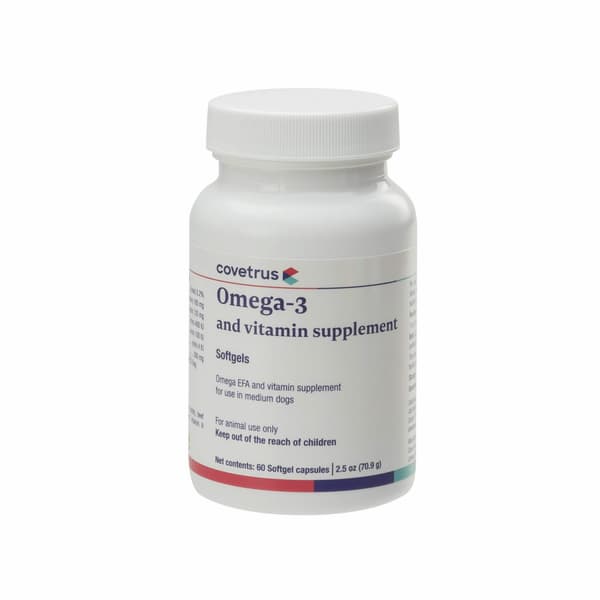

Cats and Dry Skin: Other Tips and Advice

While some cases of dry skin in cats can’t be avoided, there are several steps you can take to reduce the risk and keep your cat’s skin healthy. These include:
- Feeding a balanced, high-quality diet to support skin and coat health
- Providing year-round parasite prevention to guard against fleas, mites, and related skin issues
- Maintaining a comfortable indoor environment with proper humidity and hydration
- Sticking to a regular grooming routine to remove dead skin and distribute natural oils
- Scheduling routine veterinary checkups to catch underlying health problems early and get personalized care recommendations
By staying proactive, you can help keep your cat’s skin hydrated and comfortable year-round.
